Brand Management Report: Lidl GB Store Marketing Strategies
VerifiedAdded on 2022/12/28
|18
|5362
|36
Report
AI Summary
This comprehensive report delves into the intricacies of brand management, using Lidl GB as a case study. It begins by highlighting the significance of branding as a marketing tool, tracing its emergence in business practices, and then dissecting the key components of a successful brand strategy. The report examines how brands are successfully managed, applying relevant theories and models. It further explores portfolio management, brand hierarchies, and brand equity management, critically analyzing these concepts with appropriate frameworks. Additionally, it investigates collaborative brand management strategies, both domestically and globally, and evaluates techniques used to leverage and extend brands. Finally, the report covers techniques for measuring and managing brand value, culminating in an in-depth discussion of the evaluation underpinned by justified evidence and understanding of branding. The report provides a detailed analysis of how brand value is measured and managed in creating a strong brand.
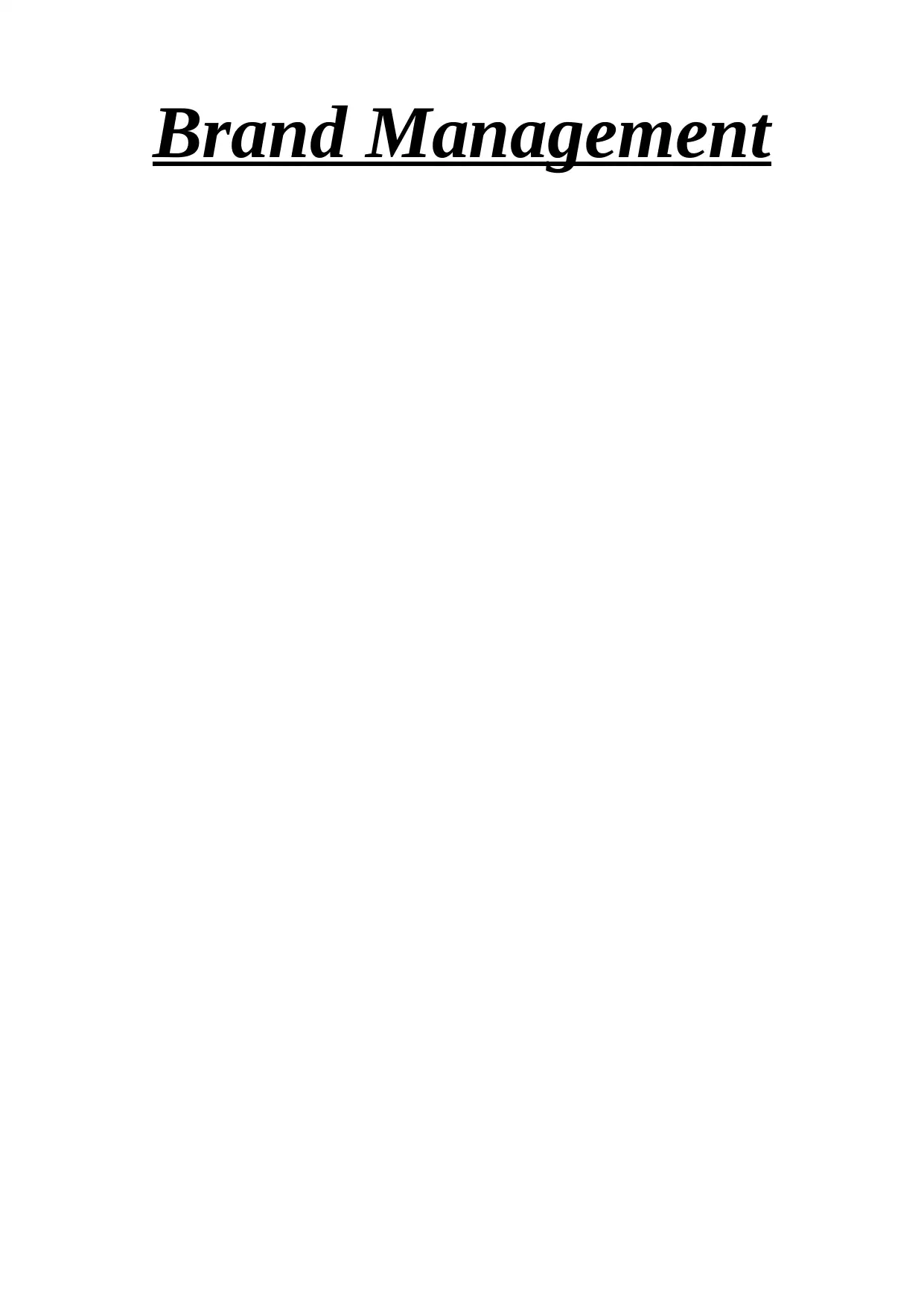
Brand Management
Paraphrase This Document
Need a fresh take? Get an instant paraphrase of this document with our AI Paraphraser
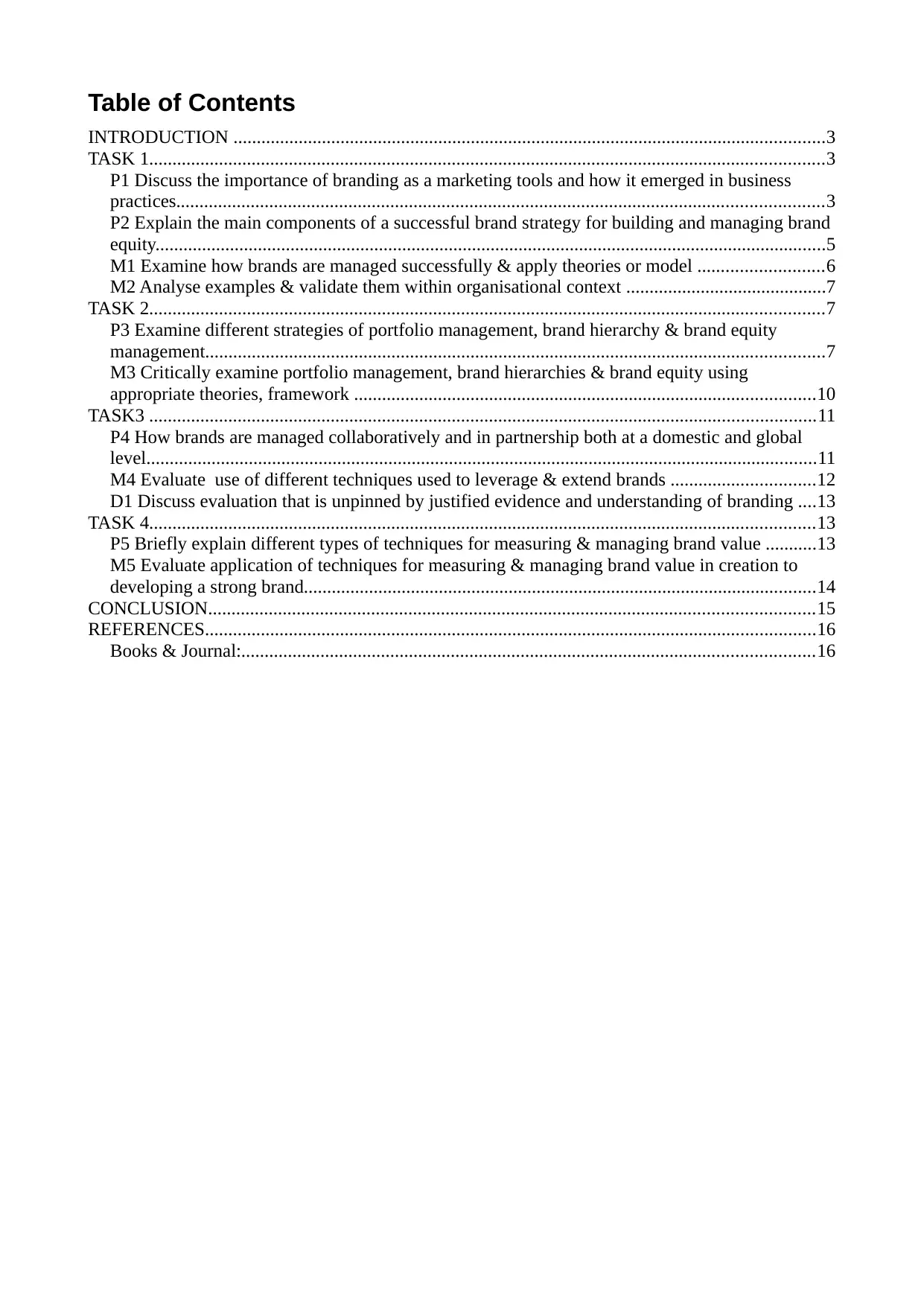
Table of Contents
INTRODUCTION ...............................................................................................................................3
TASK 1.................................................................................................................................................3
P1 Discuss the importance of branding as a marketing tools and how it emerged in business
practices...........................................................................................................................................3
P2 Explain the main components of a successful brand strategy for building and managing brand
equity................................................................................................................................................5
M1 Examine how brands are managed successfully & apply theories or model ...........................6
M2 Analyse examples & validate them within organisational context ...........................................7
TASK 2.................................................................................................................................................7
P3 Examine different strategies of portfolio management, brand hierarchy & brand equity
management.....................................................................................................................................7
M3 Critically examine portfolio management, brand hierarchies & brand equity using
appropriate theories, framework ...................................................................................................10
TASK3 ...............................................................................................................................................11
P4 How brands are managed collaboratively and in partnership both at a domestic and global
level................................................................................................................................................11
M4 Evaluate use of different techniques used to leverage & extend brands ...............................12
D1 Discuss evaluation that is unpinned by justified evidence and understanding of branding ....13
TASK 4...............................................................................................................................................13
P5 Briefly explain different types of techniques for measuring & managing brand value ...........13
M5 Evaluate application of techniques for measuring & managing brand value in creation to
developing a strong brand..............................................................................................................14
CONCLUSION..................................................................................................................................15
REFERENCES...................................................................................................................................16
Books & Journal:...........................................................................................................................16
INTRODUCTION ...............................................................................................................................3
TASK 1.................................................................................................................................................3
P1 Discuss the importance of branding as a marketing tools and how it emerged in business
practices...........................................................................................................................................3
P2 Explain the main components of a successful brand strategy for building and managing brand
equity................................................................................................................................................5
M1 Examine how brands are managed successfully & apply theories or model ...........................6
M2 Analyse examples & validate them within organisational context ...........................................7
TASK 2.................................................................................................................................................7
P3 Examine different strategies of portfolio management, brand hierarchy & brand equity
management.....................................................................................................................................7
M3 Critically examine portfolio management, brand hierarchies & brand equity using
appropriate theories, framework ...................................................................................................10
TASK3 ...............................................................................................................................................11
P4 How brands are managed collaboratively and in partnership both at a domestic and global
level................................................................................................................................................11
M4 Evaluate use of different techniques used to leverage & extend brands ...............................12
D1 Discuss evaluation that is unpinned by justified evidence and understanding of branding ....13
TASK 4...............................................................................................................................................13
P5 Briefly explain different types of techniques for measuring & managing brand value ...........13
M5 Evaluate application of techniques for measuring & managing brand value in creation to
developing a strong brand..............................................................................................................14
CONCLUSION..................................................................................................................................15
REFERENCES...................................................................................................................................16
Books & Journal:...........................................................................................................................16
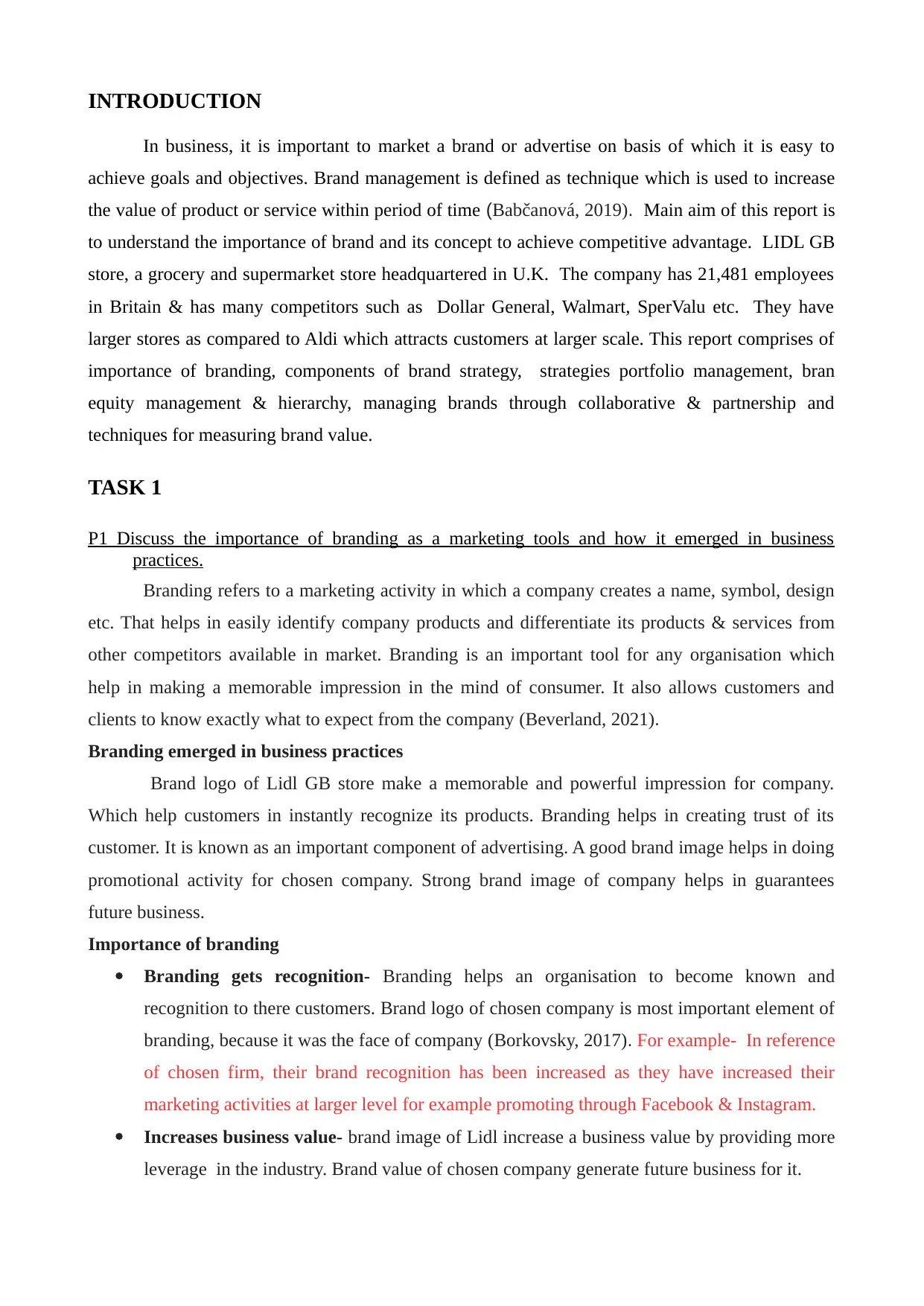
INTRODUCTION
In business, it is important to market a brand or advertise on basis of which it is easy to
achieve goals and objectives. Brand management is defined as technique which is used to increase
the value of product or service within period of time (Babčanová, 2019). Main aim of this report is
to understand the importance of brand and its concept to achieve competitive advantage. LIDL GB
store, a grocery and supermarket store headquartered in U.K. The company has 21,481 employees
in Britain & has many competitors such as Dollar General, Walmart, SperValu etc. They have
larger stores as compared to Aldi which attracts customers at larger scale. This report comprises of
importance of branding, components of brand strategy, strategies portfolio management, bran
equity management & hierarchy, managing brands through collaborative & partnership and
techniques for measuring brand value.
TASK 1
P1 Discuss the importance of branding as a marketing tools and how it emerged in business
practices.
Branding refers to a marketing activity in which a company creates a name, symbol, design
etc. That helps in easily identify company products and differentiate its products & services from
other competitors available in market. Branding is an important tool for any organisation which
help in making a memorable impression in the mind of consumer. It also allows customers and
clients to know exactly what to expect from the company (Beverland, 2021).
Branding emerged in business practices
Brand logo of Lidl GB store make a memorable and powerful impression for company.
Which help customers in instantly recognize its products. Branding helps in creating trust of its
customer. It is known as an important component of advertising. A good brand image helps in doing
promotional activity for chosen company. Strong brand image of company helps in guarantees
future business.
Importance of branding
Branding gets recognition- Branding helps an organisation to become known and
recognition to there customers. Brand logo of chosen company is most important element of
branding, because it was the face of company (Borkovsky, 2017). For example- In reference
of chosen firm, their brand recognition has been increased as they have increased their
marketing activities at larger level for example promoting through Facebook & Instagram.
Increases business value- brand image of Lidl increase a business value by providing more
leverage in the industry. Brand value of chosen company generate future business for it.
In business, it is important to market a brand or advertise on basis of which it is easy to
achieve goals and objectives. Brand management is defined as technique which is used to increase
the value of product or service within period of time (Babčanová, 2019). Main aim of this report is
to understand the importance of brand and its concept to achieve competitive advantage. LIDL GB
store, a grocery and supermarket store headquartered in U.K. The company has 21,481 employees
in Britain & has many competitors such as Dollar General, Walmart, SperValu etc. They have
larger stores as compared to Aldi which attracts customers at larger scale. This report comprises of
importance of branding, components of brand strategy, strategies portfolio management, bran
equity management & hierarchy, managing brands through collaborative & partnership and
techniques for measuring brand value.
TASK 1
P1 Discuss the importance of branding as a marketing tools and how it emerged in business
practices.
Branding refers to a marketing activity in which a company creates a name, symbol, design
etc. That helps in easily identify company products and differentiate its products & services from
other competitors available in market. Branding is an important tool for any organisation which
help in making a memorable impression in the mind of consumer. It also allows customers and
clients to know exactly what to expect from the company (Beverland, 2021).
Branding emerged in business practices
Brand logo of Lidl GB store make a memorable and powerful impression for company.
Which help customers in instantly recognize its products. Branding helps in creating trust of its
customer. It is known as an important component of advertising. A good brand image helps in doing
promotional activity for chosen company. Strong brand image of company helps in guarantees
future business.
Importance of branding
Branding gets recognition- Branding helps an organisation to become known and
recognition to there customers. Brand logo of chosen company is most important element of
branding, because it was the face of company (Borkovsky, 2017). For example- In reference
of chosen firm, their brand recognition has been increased as they have increased their
marketing activities at larger level for example promoting through Facebook & Instagram.
Increases business value- brand image of Lidl increase a business value by providing more
leverage in the industry. Brand value of chosen company generate future business for it.
⊘ This is a preview!⊘
Do you want full access?
Subscribe today to unlock all pages.

Trusted by 1+ million students worldwide
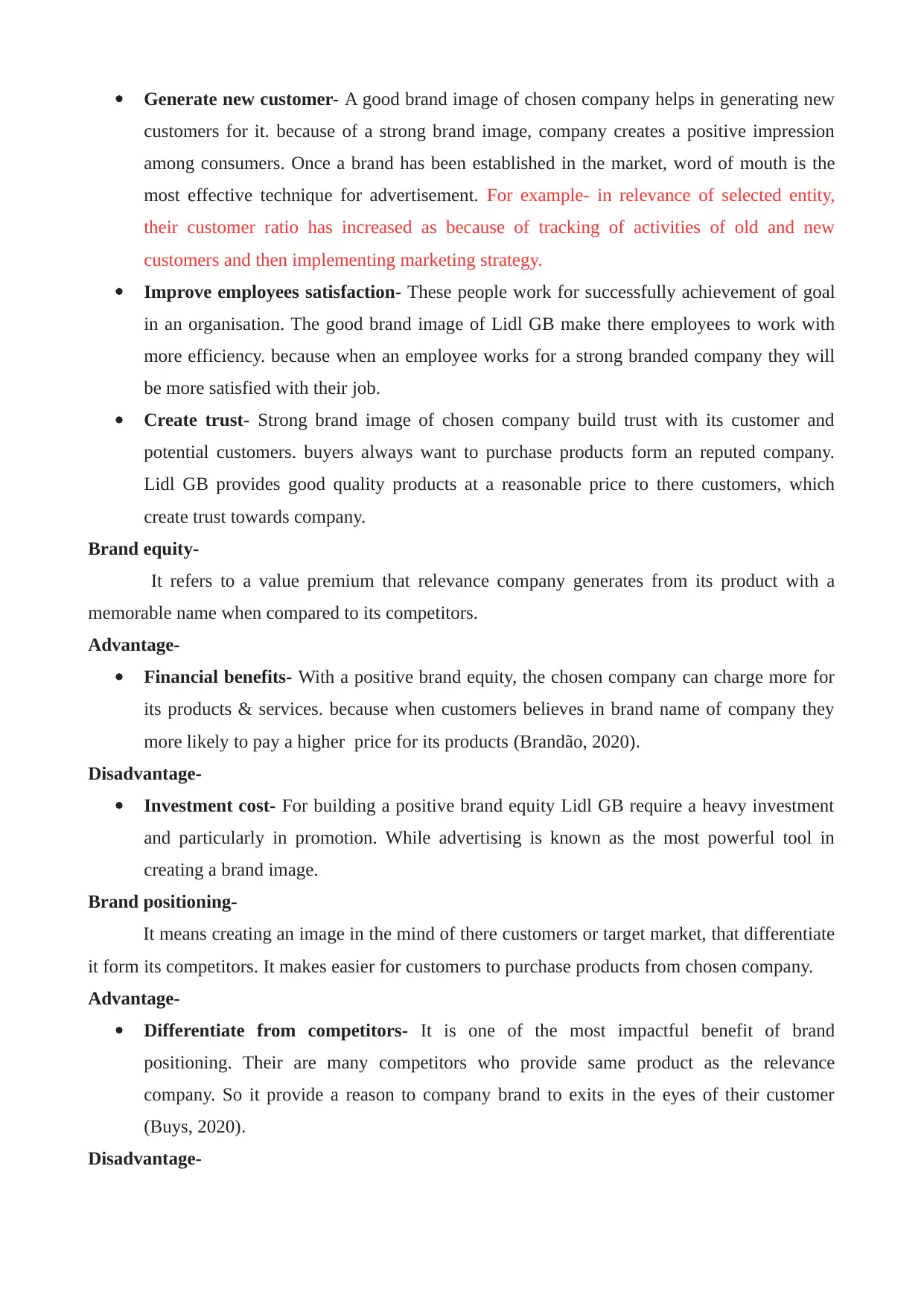
Generate new customer- A good brand image of chosen company helps in generating new
customers for it. because of a strong brand image, company creates a positive impression
among consumers. Once a brand has been established in the market, word of mouth is the
most effective technique for advertisement. For example- in relevance of selected entity,
their customer ratio has increased as because of tracking of activities of old and new
customers and then implementing marketing strategy.
Improve employees satisfaction- These people work for successfully achievement of goal
in an organisation. The good brand image of Lidl GB make there employees to work with
more efficiency. because when an employee works for a strong branded company they will
be more satisfied with their job.
Create trust- Strong brand image of chosen company build trust with its customer and
potential customers. buyers always want to purchase products form an reputed company.
Lidl GB provides good quality products at a reasonable price to there customers, which
create trust towards company.
Brand equity-
It refers to a value premium that relevance company generates from its product with a
memorable name when compared to its competitors.
Advantage-
Financial benefits- With a positive brand equity, the chosen company can charge more for
its products & services. because when customers believes in brand name of company they
more likely to pay a higher price for its products (Brandão, 2020).
Disadvantage-
Investment cost- For building a positive brand equity Lidl GB require a heavy investment
and particularly in promotion. While advertising is known as the most powerful tool in
creating a brand image.
Brand positioning-
It means creating an image in the mind of there customers or target market, that differentiate
it form its competitors. It makes easier for customers to purchase products from chosen company.
Advantage-
Differentiate from competitors- It is one of the most impactful benefit of brand
positioning. Their are many competitors who provide same product as the relevance
company. So it provide a reason to company brand to exits in the eyes of their customer
(Buys, 2020).
Disadvantage-
customers for it. because of a strong brand image, company creates a positive impression
among consumers. Once a brand has been established in the market, word of mouth is the
most effective technique for advertisement. For example- in relevance of selected entity,
their customer ratio has increased as because of tracking of activities of old and new
customers and then implementing marketing strategy.
Improve employees satisfaction- These people work for successfully achievement of goal
in an organisation. The good brand image of Lidl GB make there employees to work with
more efficiency. because when an employee works for a strong branded company they will
be more satisfied with their job.
Create trust- Strong brand image of chosen company build trust with its customer and
potential customers. buyers always want to purchase products form an reputed company.
Lidl GB provides good quality products at a reasonable price to there customers, which
create trust towards company.
Brand equity-
It refers to a value premium that relevance company generates from its product with a
memorable name when compared to its competitors.
Advantage-
Financial benefits- With a positive brand equity, the chosen company can charge more for
its products & services. because when customers believes in brand name of company they
more likely to pay a higher price for its products (Brandão, 2020).
Disadvantage-
Investment cost- For building a positive brand equity Lidl GB require a heavy investment
and particularly in promotion. While advertising is known as the most powerful tool in
creating a brand image.
Brand positioning-
It means creating an image in the mind of there customers or target market, that differentiate
it form its competitors. It makes easier for customers to purchase products from chosen company.
Advantage-
Differentiate from competitors- It is one of the most impactful benefit of brand
positioning. Their are many competitors who provide same product as the relevance
company. So it provide a reason to company brand to exits in the eyes of their customer
(Buys, 2020).
Disadvantage-
Paraphrase This Document
Need a fresh take? Get an instant paraphrase of this document with our AI Paraphraser
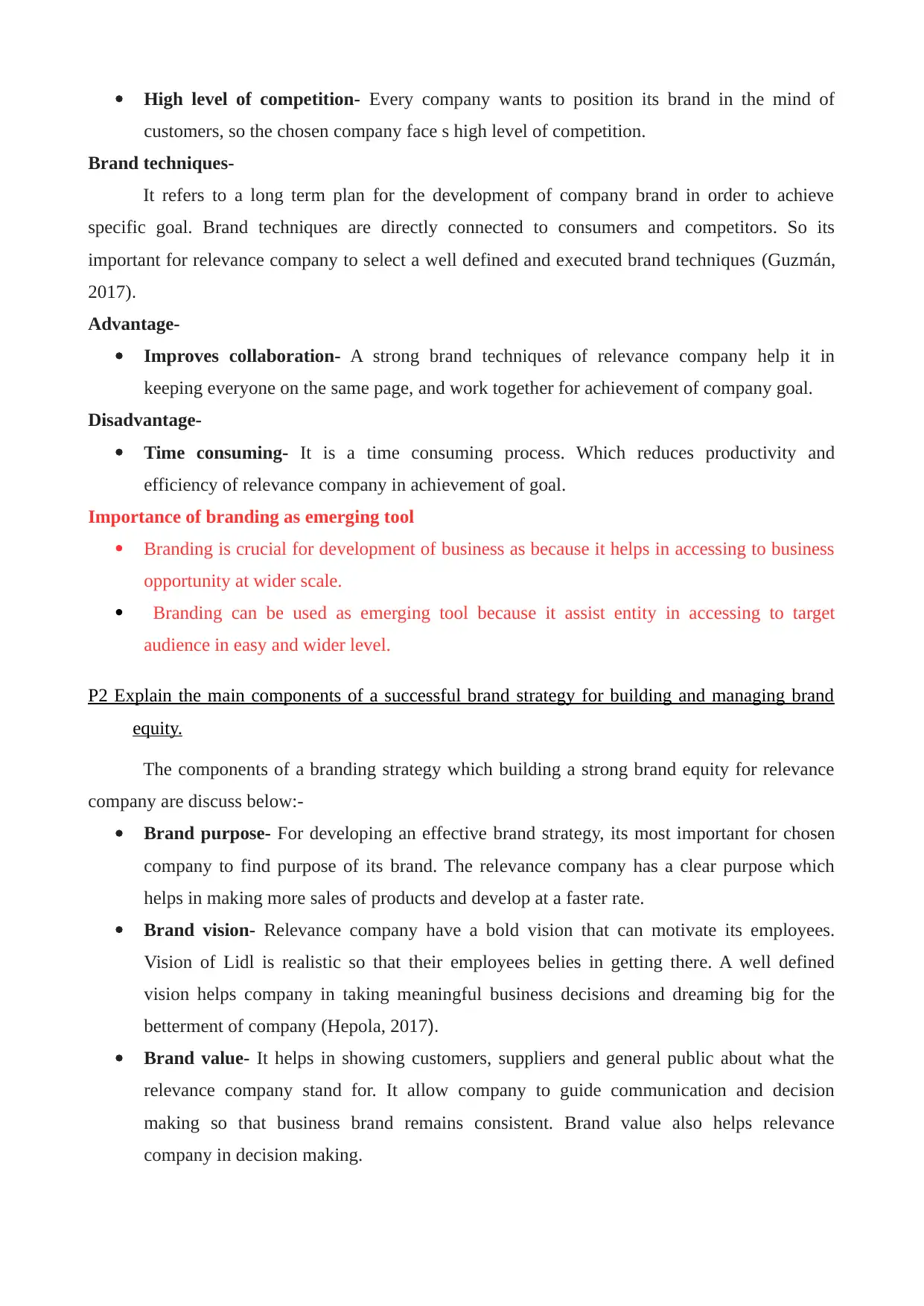
High level of competition- Every company wants to position its brand in the mind of
customers, so the chosen company face s high level of competition.
Brand techniques-
It refers to a long term plan for the development of company brand in order to achieve
specific goal. Brand techniques are directly connected to consumers and competitors. So its
important for relevance company to select a well defined and executed brand techniques (Guzmán,
2017).
Advantage-
Improves collaboration- A strong brand techniques of relevance company help it in
keeping everyone on the same page, and work together for achievement of company goal.
Disadvantage-
Time consuming- It is a time consuming process. Which reduces productivity and
efficiency of relevance company in achievement of goal.
Importance of branding as emerging tool
Branding is crucial for development of business as because it helps in accessing to business
opportunity at wider scale.
Branding can be used as emerging tool because it assist entity in accessing to target
audience in easy and wider level.
P2 Explain the main components of a successful brand strategy for building and managing brand
equity.
The components of a branding strategy which building a strong brand equity for relevance
company are discuss below:-
Brand purpose- For developing an effective brand strategy, its most important for chosen
company to find purpose of its brand. The relevance company has a clear purpose which
helps in making more sales of products and develop at a faster rate.
Brand vision- Relevance company have a bold vision that can motivate its employees.
Vision of Lidl is realistic so that their employees belies in getting there. A well defined
vision helps company in taking meaningful business decisions and dreaming big for the
betterment of company (Hepola, 2017).
Brand value- It helps in showing customers, suppliers and general public about what the
relevance company stand for. It allow company to guide communication and decision
making so that business brand remains consistent. Brand value also helps relevance
company in decision making.
customers, so the chosen company face s high level of competition.
Brand techniques-
It refers to a long term plan for the development of company brand in order to achieve
specific goal. Brand techniques are directly connected to consumers and competitors. So its
important for relevance company to select a well defined and executed brand techniques (Guzmán,
2017).
Advantage-
Improves collaboration- A strong brand techniques of relevance company help it in
keeping everyone on the same page, and work together for achievement of company goal.
Disadvantage-
Time consuming- It is a time consuming process. Which reduces productivity and
efficiency of relevance company in achievement of goal.
Importance of branding as emerging tool
Branding is crucial for development of business as because it helps in accessing to business
opportunity at wider scale.
Branding can be used as emerging tool because it assist entity in accessing to target
audience in easy and wider level.
P2 Explain the main components of a successful brand strategy for building and managing brand
equity.
The components of a branding strategy which building a strong brand equity for relevance
company are discuss below:-
Brand purpose- For developing an effective brand strategy, its most important for chosen
company to find purpose of its brand. The relevance company has a clear purpose which
helps in making more sales of products and develop at a faster rate.
Brand vision- Relevance company have a bold vision that can motivate its employees.
Vision of Lidl is realistic so that their employees belies in getting there. A well defined
vision helps company in taking meaningful business decisions and dreaming big for the
betterment of company (Hepola, 2017).
Brand value- It helps in showing customers, suppliers and general public about what the
relevance company stand for. It allow company to guide communication and decision
making so that business brand remains consistent. Brand value also helps relevance
company in decision making.
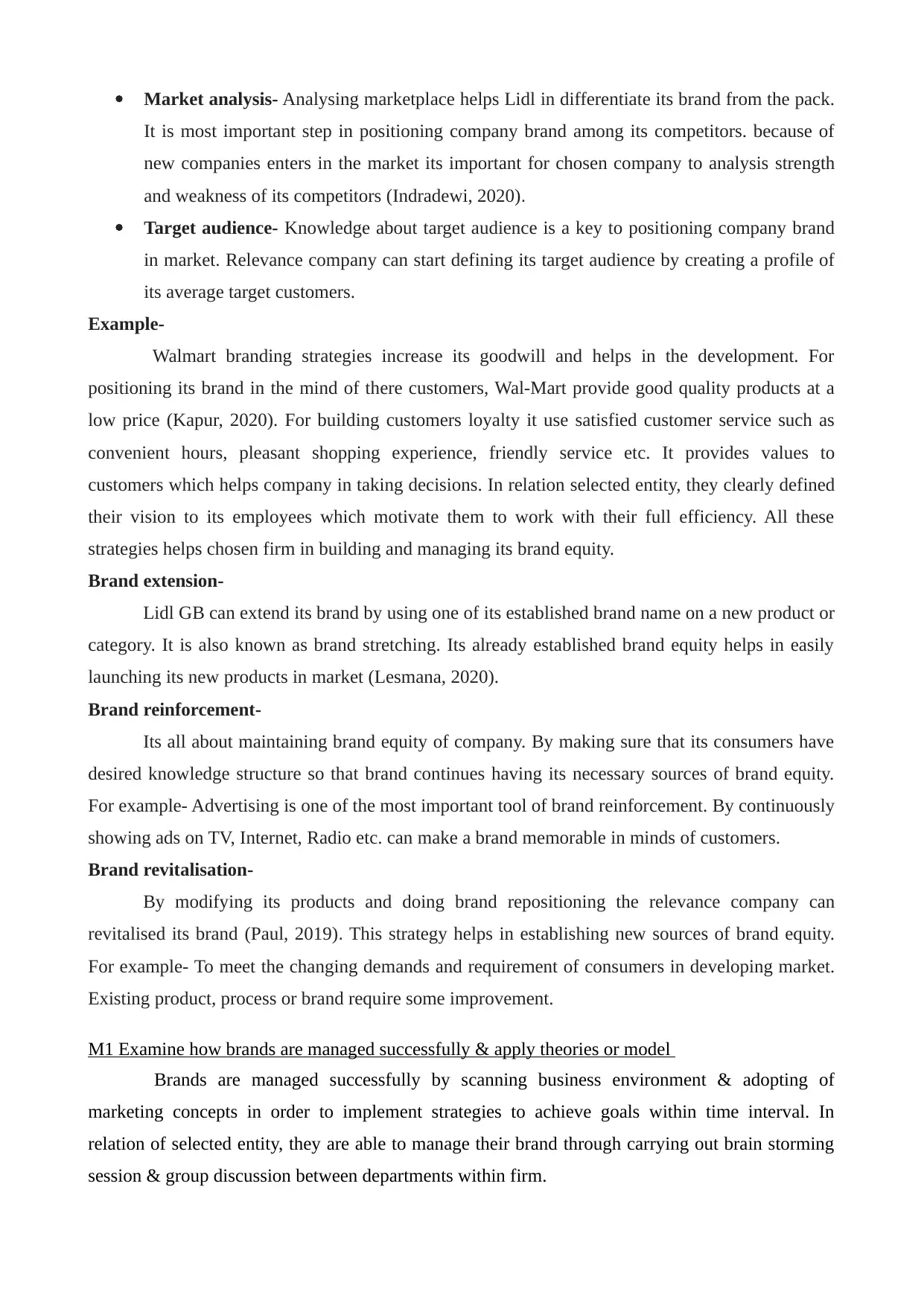
Market analysis- Analysing marketplace helps Lidl in differentiate its brand from the pack.
It is most important step in positioning company brand among its competitors. because of
new companies enters in the market its important for chosen company to analysis strength
and weakness of its competitors (Indradewi, 2020).
Target audience- Knowledge about target audience is a key to positioning company brand
in market. Relevance company can start defining its target audience by creating a profile of
its average target customers.
Example-
Walmart branding strategies increase its goodwill and helps in the development. For
positioning its brand in the mind of there customers, Wal-Mart provide good quality products at a
low price (Kapur, 2020). For building customers loyalty it use satisfied customer service such as
convenient hours, pleasant shopping experience, friendly service etc. It provides values to
customers which helps company in taking decisions. In relation selected entity, they clearly defined
their vision to its employees which motivate them to work with their full efficiency. All these
strategies helps chosen firm in building and managing its brand equity.
Brand extension-
Lidl GB can extend its brand by using one of its established brand name on a new product or
category. It is also known as brand stretching. Its already established brand equity helps in easily
launching its new products in market (Lesmana, 2020).
Brand reinforcement-
Its all about maintaining brand equity of company. By making sure that its consumers have
desired knowledge structure so that brand continues having its necessary sources of brand equity.
For example- Advertising is one of the most important tool of brand reinforcement. By continuously
showing ads on TV, Internet, Radio etc. can make a brand memorable in minds of customers.
Brand revitalisation-
By modifying its products and doing brand repositioning the relevance company can
revitalised its brand (Paul, 2019). This strategy helps in establishing new sources of brand equity.
For example- To meet the changing demands and requirement of consumers in developing market.
Existing product, process or brand require some improvement.
M1 Examine how brands are managed successfully & apply theories or model
Brands are managed successfully by scanning business environment & adopting of
marketing concepts in order to implement strategies to achieve goals within time interval. In
relation of selected entity, they are able to manage their brand through carrying out brain storming
session & group discussion between departments within firm.
It is most important step in positioning company brand among its competitors. because of
new companies enters in the market its important for chosen company to analysis strength
and weakness of its competitors (Indradewi, 2020).
Target audience- Knowledge about target audience is a key to positioning company brand
in market. Relevance company can start defining its target audience by creating a profile of
its average target customers.
Example-
Walmart branding strategies increase its goodwill and helps in the development. For
positioning its brand in the mind of there customers, Wal-Mart provide good quality products at a
low price (Kapur, 2020). For building customers loyalty it use satisfied customer service such as
convenient hours, pleasant shopping experience, friendly service etc. It provides values to
customers which helps company in taking decisions. In relation selected entity, they clearly defined
their vision to its employees which motivate them to work with their full efficiency. All these
strategies helps chosen firm in building and managing its brand equity.
Brand extension-
Lidl GB can extend its brand by using one of its established brand name on a new product or
category. It is also known as brand stretching. Its already established brand equity helps in easily
launching its new products in market (Lesmana, 2020).
Brand reinforcement-
Its all about maintaining brand equity of company. By making sure that its consumers have
desired knowledge structure so that brand continues having its necessary sources of brand equity.
For example- Advertising is one of the most important tool of brand reinforcement. By continuously
showing ads on TV, Internet, Radio etc. can make a brand memorable in minds of customers.
Brand revitalisation-
By modifying its products and doing brand repositioning the relevance company can
revitalised its brand (Paul, 2019). This strategy helps in establishing new sources of brand equity.
For example- To meet the changing demands and requirement of consumers in developing market.
Existing product, process or brand require some improvement.
M1 Examine how brands are managed successfully & apply theories or model
Brands are managed successfully by scanning business environment & adopting of
marketing concepts in order to implement strategies to achieve goals within time interval. In
relation of selected entity, they are able to manage their brand through carrying out brain storming
session & group discussion between departments within firm.
⊘ This is a preview!⊘
Do you want full access?
Subscribe today to unlock all pages.

Trusted by 1+ million students worldwide
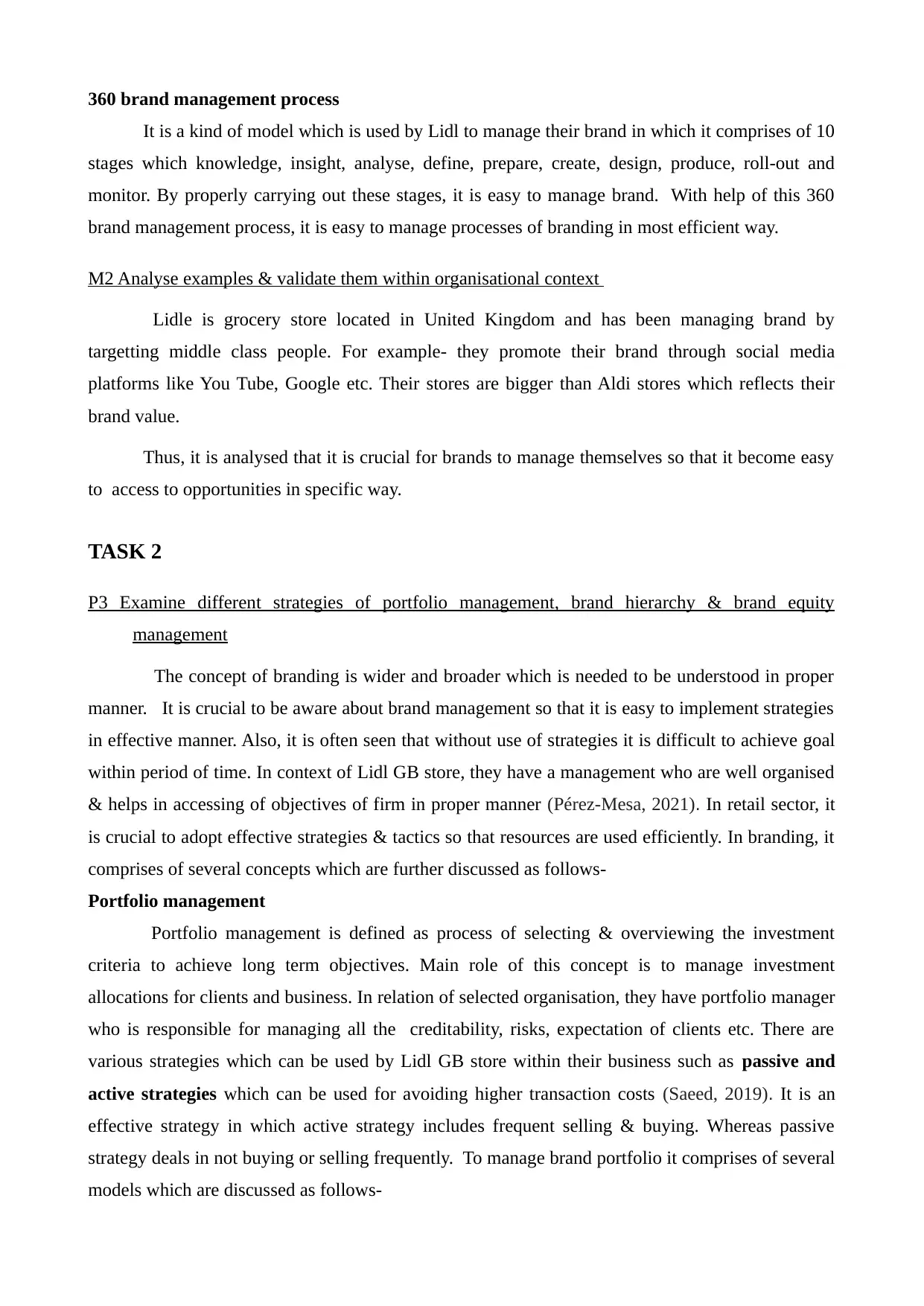
360 brand management process
It is a kind of model which is used by Lidl to manage their brand in which it comprises of 10
stages which knowledge, insight, analyse, define, prepare, create, design, produce, roll-out and
monitor. By properly carrying out these stages, it is easy to manage brand. With help of this 360
brand management process, it is easy to manage processes of branding in most efficient way.
M2 Analyse examples & validate them within organisational context
Lidle is grocery store located in United Kingdom and has been managing brand by
targetting middle class people. For example- they promote their brand through social media
platforms like You Tube, Google etc. Their stores are bigger than Aldi stores which reflects their
brand value.
Thus, it is analysed that it is crucial for brands to manage themselves so that it become easy
to access to opportunities in specific way.
TASK 2
P3 Examine different strategies of portfolio management, brand hierarchy & brand equity
management
The concept of branding is wider and broader which is needed to be understood in proper
manner. It is crucial to be aware about brand management so that it is easy to implement strategies
in effective manner. Also, it is often seen that without use of strategies it is difficult to achieve goal
within period of time. In context of Lidl GB store, they have a management who are well organised
& helps in accessing of objectives of firm in proper manner (Pérez-Mesa, 2021). In retail sector, it
is crucial to adopt effective strategies & tactics so that resources are used efficiently. In branding, it
comprises of several concepts which are further discussed as follows-
Portfolio management
Portfolio management is defined as process of selecting & overviewing the investment
criteria to achieve long term objectives. Main role of this concept is to manage investment
allocations for clients and business. In relation of selected organisation, they have portfolio manager
who is responsible for managing all the creditability, risks, expectation of clients etc. There are
various strategies which can be used by Lidl GB store within their business such as passive and
active strategies which can be used for avoiding higher transaction costs (Saeed, 2019). It is an
effective strategy in which active strategy includes frequent selling & buying. Whereas passive
strategy deals in not buying or selling frequently. To manage brand portfolio it comprises of several
models which are discussed as follows-
It is a kind of model which is used by Lidl to manage their brand in which it comprises of 10
stages which knowledge, insight, analyse, define, prepare, create, design, produce, roll-out and
monitor. By properly carrying out these stages, it is easy to manage brand. With help of this 360
brand management process, it is easy to manage processes of branding in most efficient way.
M2 Analyse examples & validate them within organisational context
Lidle is grocery store located in United Kingdom and has been managing brand by
targetting middle class people. For example- they promote their brand through social media
platforms like You Tube, Google etc. Their stores are bigger than Aldi stores which reflects their
brand value.
Thus, it is analysed that it is crucial for brands to manage themselves so that it become easy
to access to opportunities in specific way.
TASK 2
P3 Examine different strategies of portfolio management, brand hierarchy & brand equity
management
The concept of branding is wider and broader which is needed to be understood in proper
manner. It is crucial to be aware about brand management so that it is easy to implement strategies
in effective manner. Also, it is often seen that without use of strategies it is difficult to achieve goal
within period of time. In context of Lidl GB store, they have a management who are well organised
& helps in accessing of objectives of firm in proper manner (Pérez-Mesa, 2021). In retail sector, it
is crucial to adopt effective strategies & tactics so that resources are used efficiently. In branding, it
comprises of several concepts which are further discussed as follows-
Portfolio management
Portfolio management is defined as process of selecting & overviewing the investment
criteria to achieve long term objectives. Main role of this concept is to manage investment
allocations for clients and business. In relation of selected organisation, they have portfolio manager
who is responsible for managing all the creditability, risks, expectation of clients etc. There are
various strategies which can be used by Lidl GB store within their business such as passive and
active strategies which can be used for avoiding higher transaction costs (Saeed, 2019). It is an
effective strategy in which active strategy includes frequent selling & buying. Whereas passive
strategy deals in not buying or selling frequently. To manage brand portfolio it comprises of several
models which are discussed as follows-
Paraphrase This Document
Need a fresh take? Get an instant paraphrase of this document with our AI Paraphraser
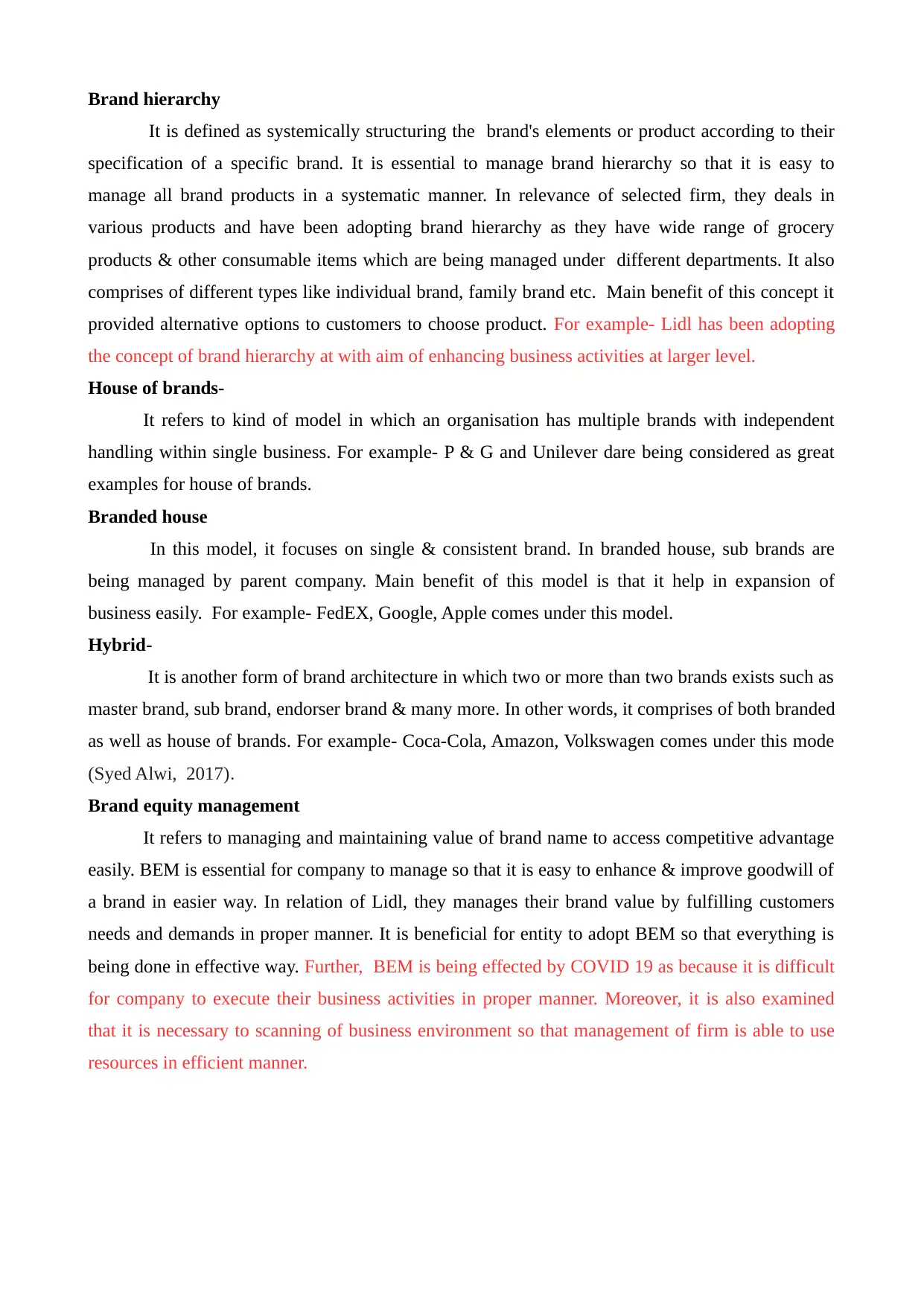
Brand hierarchy
It is defined as systemically structuring the brand's elements or product according to their
specification of a specific brand. It is essential to manage brand hierarchy so that it is easy to
manage all brand products in a systematic manner. In relevance of selected firm, they deals in
various products and have been adopting brand hierarchy as they have wide range of grocery
products & other consumable items which are being managed under different departments. It also
comprises of different types like individual brand, family brand etc. Main benefit of this concept it
provided alternative options to customers to choose product. For example- Lidl has been adopting
the concept of brand hierarchy at with aim of enhancing business activities at larger level.
House of brands-
It refers to kind of model in which an organisation has multiple brands with independent
handling within single business. For example- P & G and Unilever dare being considered as great
examples for house of brands.
Branded house
In this model, it focuses on single & consistent brand. In branded house, sub brands are
being managed by parent company. Main benefit of this model is that it help in expansion of
business easily. For example- FedEX, Google, Apple comes under this model.
Hybrid-
It is another form of brand architecture in which two or more than two brands exists such as
master brand, sub brand, endorser brand & many more. In other words, it comprises of both branded
as well as house of brands. For example- Coca-Cola, Amazon, Volkswagen comes under this mode
(Syed Alwi, 2017).
Brand equity management
It refers to managing and maintaining value of brand name to access competitive advantage
easily. BEM is essential for company to manage so that it is easy to enhance & improve goodwill of
a brand in easier way. In relation of Lidl, they manages their brand value by fulfilling customers
needs and demands in proper manner. It is beneficial for entity to adopt BEM so that everything is
being done in effective way. Further, BEM is being effected by COVID 19 as because it is difficult
for company to execute their business activities in proper manner. Moreover, it is also examined
that it is necessary to scanning of business environment so that management of firm is able to use
resources in efficient manner.
It is defined as systemically structuring the brand's elements or product according to their
specification of a specific brand. It is essential to manage brand hierarchy so that it is easy to
manage all brand products in a systematic manner. In relevance of selected firm, they deals in
various products and have been adopting brand hierarchy as they have wide range of grocery
products & other consumable items which are being managed under different departments. It also
comprises of different types like individual brand, family brand etc. Main benefit of this concept it
provided alternative options to customers to choose product. For example- Lidl has been adopting
the concept of brand hierarchy at with aim of enhancing business activities at larger level.
House of brands-
It refers to kind of model in which an organisation has multiple brands with independent
handling within single business. For example- P & G and Unilever dare being considered as great
examples for house of brands.
Branded house
In this model, it focuses on single & consistent brand. In branded house, sub brands are
being managed by parent company. Main benefit of this model is that it help in expansion of
business easily. For example- FedEX, Google, Apple comes under this model.
Hybrid-
It is another form of brand architecture in which two or more than two brands exists such as
master brand, sub brand, endorser brand & many more. In other words, it comprises of both branded
as well as house of brands. For example- Coca-Cola, Amazon, Volkswagen comes under this mode
(Syed Alwi, 2017).
Brand equity management
It refers to managing and maintaining value of brand name to access competitive advantage
easily. BEM is essential for company to manage so that it is easy to enhance & improve goodwill of
a brand in easier way. In relation of Lidl, they manages their brand value by fulfilling customers
needs and demands in proper manner. It is beneficial for entity to adopt BEM so that everything is
being done in effective way. Further, BEM is being effected by COVID 19 as because it is difficult
for company to execute their business activities in proper manner. Moreover, it is also examined
that it is necessary to scanning of business environment so that management of firm is able to use
resources in efficient manner.
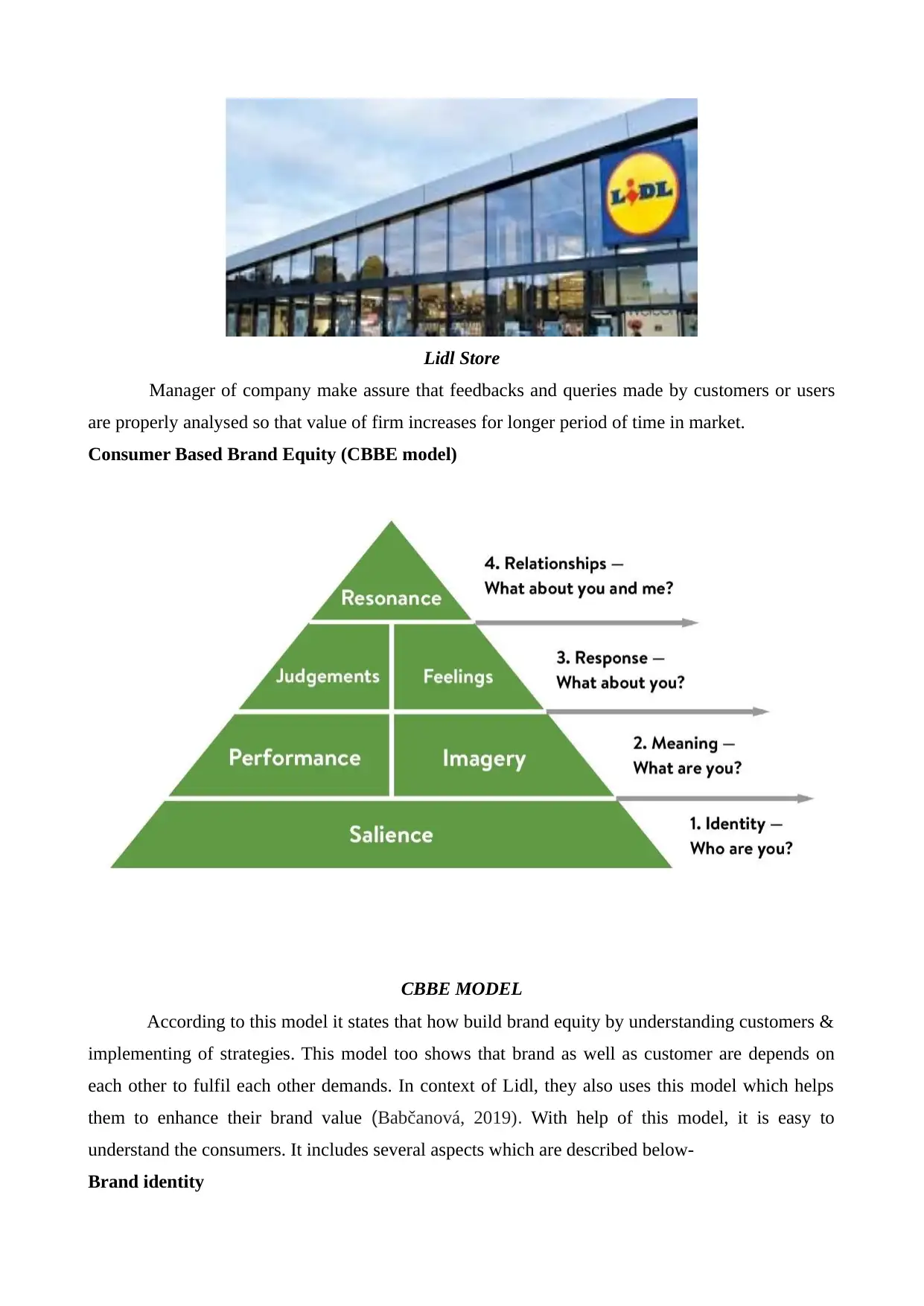
Lidl Store
Manager of company make assure that feedbacks and queries made by customers or users
are properly analysed so that value of firm increases for longer period of time in market.
Consumer Based Brand Equity (CBBE model)
CBBE MODEL
According to this model it states that how build brand equity by understanding customers &
implementing of strategies. This model too shows that brand as well as customer are depends on
each other to fulfil each other demands. In context of Lidl, they also uses this model which helps
them to enhance their brand value (Babčanová, 2019). With help of this model, it is easy to
understand the consumers. It includes several aspects which are described below-
Brand identity
Manager of company make assure that feedbacks and queries made by customers or users
are properly analysed so that value of firm increases for longer period of time in market.
Consumer Based Brand Equity (CBBE model)
CBBE MODEL
According to this model it states that how build brand equity by understanding customers &
implementing of strategies. This model too shows that brand as well as customer are depends on
each other to fulfil each other demands. In context of Lidl, they also uses this model which helps
them to enhance their brand value (Babčanová, 2019). With help of this model, it is easy to
understand the consumers. It includes several aspects which are described below-
Brand identity
⊘ This is a preview!⊘
Do you want full access?
Subscribe today to unlock all pages.

Trusted by 1+ million students worldwide
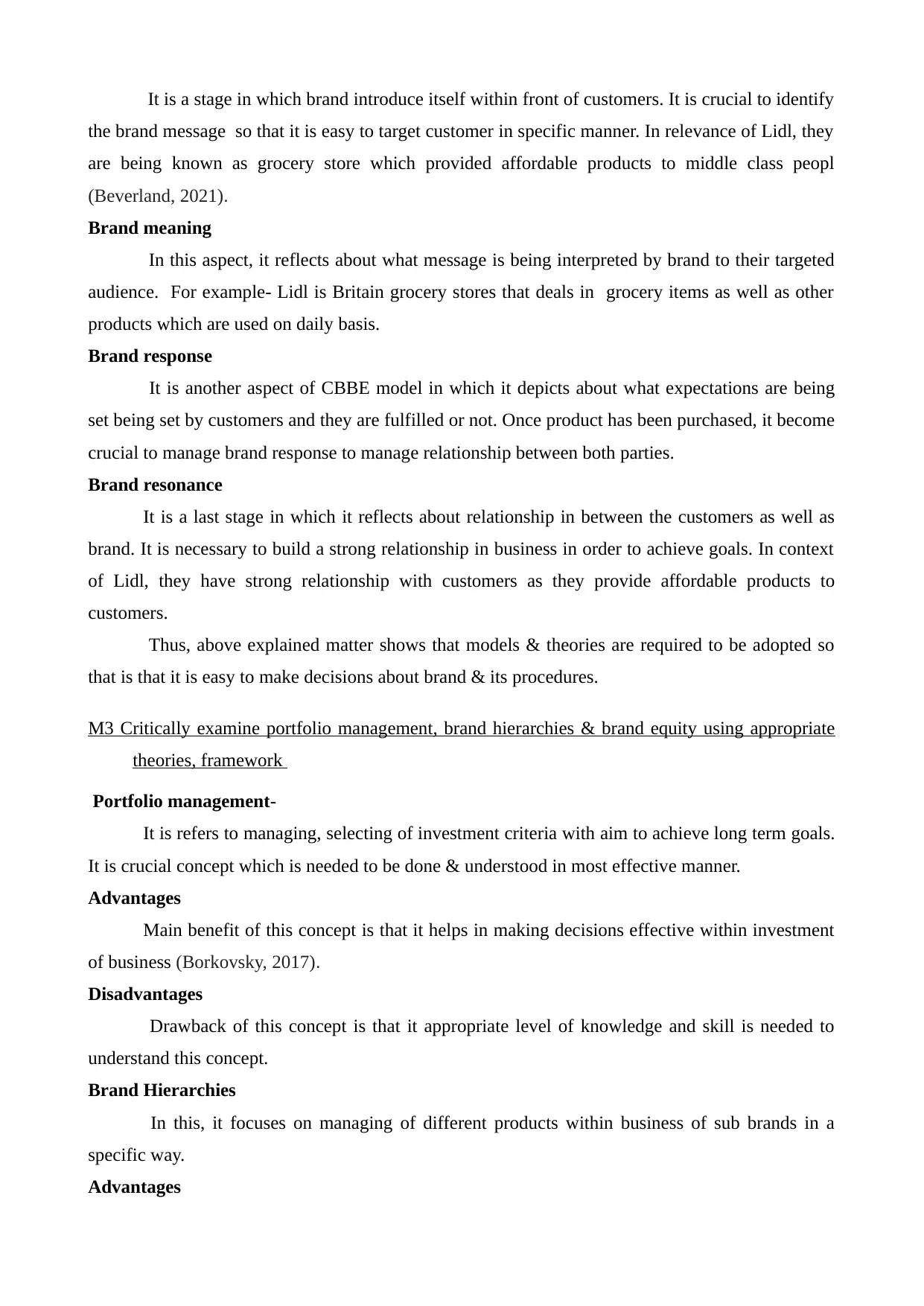
It is a stage in which brand introduce itself within front of customers. It is crucial to identify
the brand message so that it is easy to target customer in specific manner. In relevance of Lidl, they
are being known as grocery store which provided affordable products to middle class peopl
(Beverland, 2021).
Brand meaning
In this aspect, it reflects about what message is being interpreted by brand to their targeted
audience. For example- Lidl is Britain grocery stores that deals in grocery items as well as other
products which are used on daily basis.
Brand response
It is another aspect of CBBE model in which it depicts about what expectations are being
set being set by customers and they are fulfilled or not. Once product has been purchased, it become
crucial to manage brand response to manage relationship between both parties.
Brand resonance
It is a last stage in which it reflects about relationship in between the customers as well as
brand. It is necessary to build a strong relationship in business in order to achieve goals. In context
of Lidl, they have strong relationship with customers as they provide affordable products to
customers.
Thus, above explained matter shows that models & theories are required to be adopted so
that is that it is easy to make decisions about brand & its procedures.
M3 Critically examine portfolio management, brand hierarchies & brand equity using appropriate
theories, framework
Portfolio management-
It is refers to managing, selecting of investment criteria with aim to achieve long term goals.
It is crucial concept which is needed to be done & understood in most effective manner.
Advantages
Main benefit of this concept is that it helps in making decisions effective within investment
of business (Borkovsky, 2017).
Disadvantages
Drawback of this concept is that it appropriate level of knowledge and skill is needed to
understand this concept.
Brand Hierarchies
In this, it focuses on managing of different products within business of sub brands in a
specific way.
Advantages
the brand message so that it is easy to target customer in specific manner. In relevance of Lidl, they
are being known as grocery store which provided affordable products to middle class peopl
(Beverland, 2021).
Brand meaning
In this aspect, it reflects about what message is being interpreted by brand to their targeted
audience. For example- Lidl is Britain grocery stores that deals in grocery items as well as other
products which are used on daily basis.
Brand response
It is another aspect of CBBE model in which it depicts about what expectations are being
set being set by customers and they are fulfilled or not. Once product has been purchased, it become
crucial to manage brand response to manage relationship between both parties.
Brand resonance
It is a last stage in which it reflects about relationship in between the customers as well as
brand. It is necessary to build a strong relationship in business in order to achieve goals. In context
of Lidl, they have strong relationship with customers as they provide affordable products to
customers.
Thus, above explained matter shows that models & theories are required to be adopted so
that is that it is easy to make decisions about brand & its procedures.
M3 Critically examine portfolio management, brand hierarchies & brand equity using appropriate
theories, framework
Portfolio management-
It is refers to managing, selecting of investment criteria with aim to achieve long term goals.
It is crucial concept which is needed to be done & understood in most effective manner.
Advantages
Main benefit of this concept is that it helps in making decisions effective within investment
of business (Borkovsky, 2017).
Disadvantages
Drawback of this concept is that it appropriate level of knowledge and skill is needed to
understand this concept.
Brand Hierarchies
In this, it focuses on managing of different products within business of sub brands in a
specific way.
Advantages
Paraphrase This Document
Need a fresh take? Get an instant paraphrase of this document with our AI Paraphraser
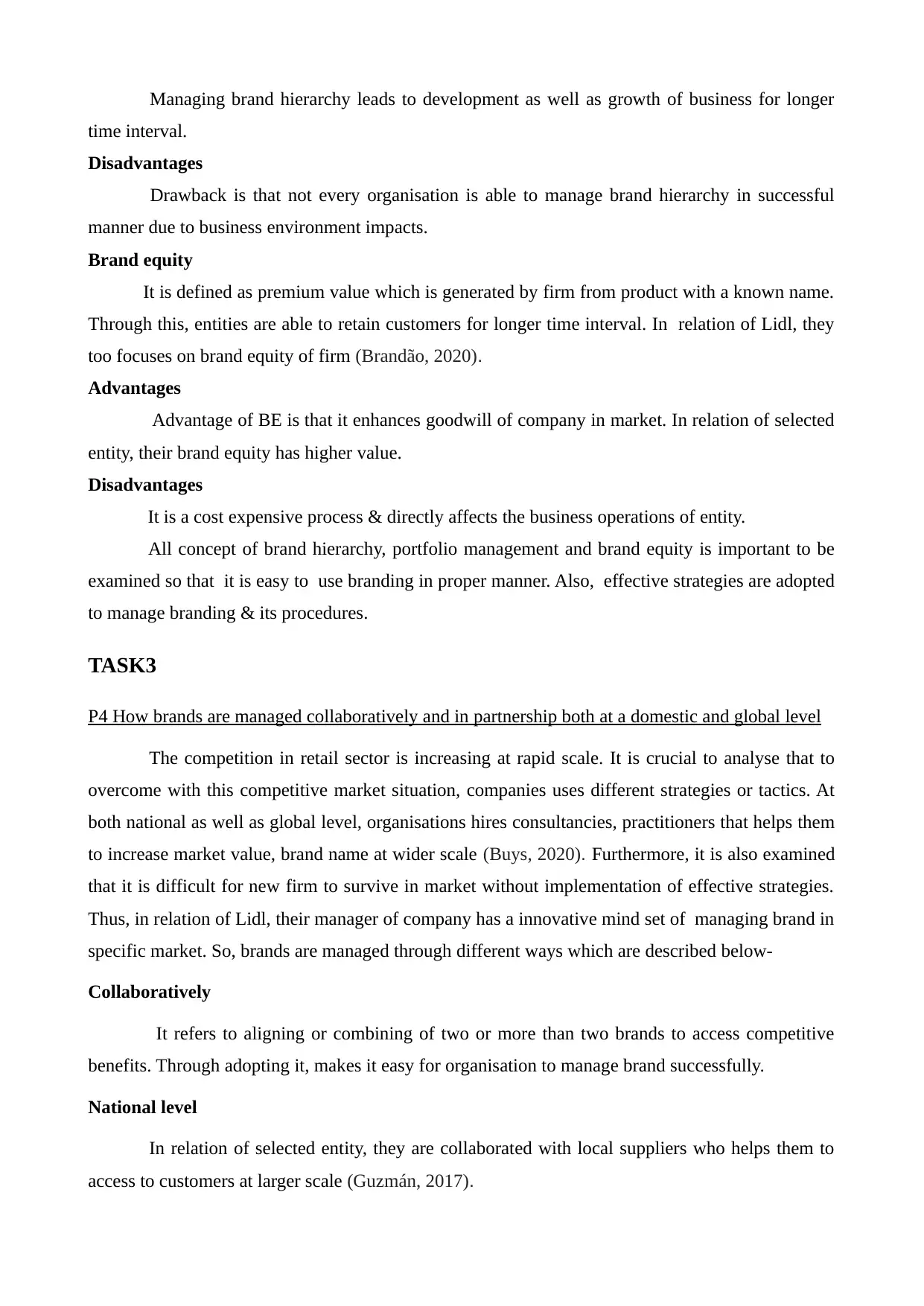
Managing brand hierarchy leads to development as well as growth of business for longer
time interval.
Disadvantages
Drawback is that not every organisation is able to manage brand hierarchy in successful
manner due to business environment impacts.
Brand equity
It is defined as premium value which is generated by firm from product with a known name.
Through this, entities are able to retain customers for longer time interval. In relation of Lidl, they
too focuses on brand equity of firm (Brandão, 2020).
Advantages
Advantage of BE is that it enhances goodwill of company in market. In relation of selected
entity, their brand equity has higher value.
Disadvantages
It is a cost expensive process & directly affects the business operations of entity.
All concept of brand hierarchy, portfolio management and brand equity is important to be
examined so that it is easy to use branding in proper manner. Also, effective strategies are adopted
to manage branding & its procedures.
TASK3
P4 How brands are managed collaboratively and in partnership both at a domestic and global level
The competition in retail sector is increasing at rapid scale. It is crucial to analyse that to
overcome with this competitive market situation, companies uses different strategies or tactics. At
both national as well as global level, organisations hires consultancies, practitioners that helps them
to increase market value, brand name at wider scale (Buys, 2020). Furthermore, it is also examined
that it is difficult for new firm to survive in market without implementation of effective strategies.
Thus, in relation of Lidl, their manager of company has a innovative mind set of managing brand in
specific market. So, brands are managed through different ways which are described below-
Collaboratively
It refers to aligning or combining of two or more than two brands to access competitive
benefits. Through adopting it, makes it easy for organisation to manage brand successfully.
National level
In relation of selected entity, they are collaborated with local suppliers who helps them to
access to customers at larger scale (Guzmán, 2017).
time interval.
Disadvantages
Drawback is that not every organisation is able to manage brand hierarchy in successful
manner due to business environment impacts.
Brand equity
It is defined as premium value which is generated by firm from product with a known name.
Through this, entities are able to retain customers for longer time interval. In relation of Lidl, they
too focuses on brand equity of firm (Brandão, 2020).
Advantages
Advantage of BE is that it enhances goodwill of company in market. In relation of selected
entity, their brand equity has higher value.
Disadvantages
It is a cost expensive process & directly affects the business operations of entity.
All concept of brand hierarchy, portfolio management and brand equity is important to be
examined so that it is easy to use branding in proper manner. Also, effective strategies are adopted
to manage branding & its procedures.
TASK3
P4 How brands are managed collaboratively and in partnership both at a domestic and global level
The competition in retail sector is increasing at rapid scale. It is crucial to analyse that to
overcome with this competitive market situation, companies uses different strategies or tactics. At
both national as well as global level, organisations hires consultancies, practitioners that helps them
to increase market value, brand name at wider scale (Buys, 2020). Furthermore, it is also examined
that it is difficult for new firm to survive in market without implementation of effective strategies.
Thus, in relation of Lidl, their manager of company has a innovative mind set of managing brand in
specific market. So, brands are managed through different ways which are described below-
Collaboratively
It refers to aligning or combining of two or more than two brands to access competitive
benefits. Through adopting it, makes it easy for organisation to manage brand successfully.
National level
In relation of selected entity, they are collaborated with local suppliers who helps them to
access to customers at larger scale (Guzmán, 2017).
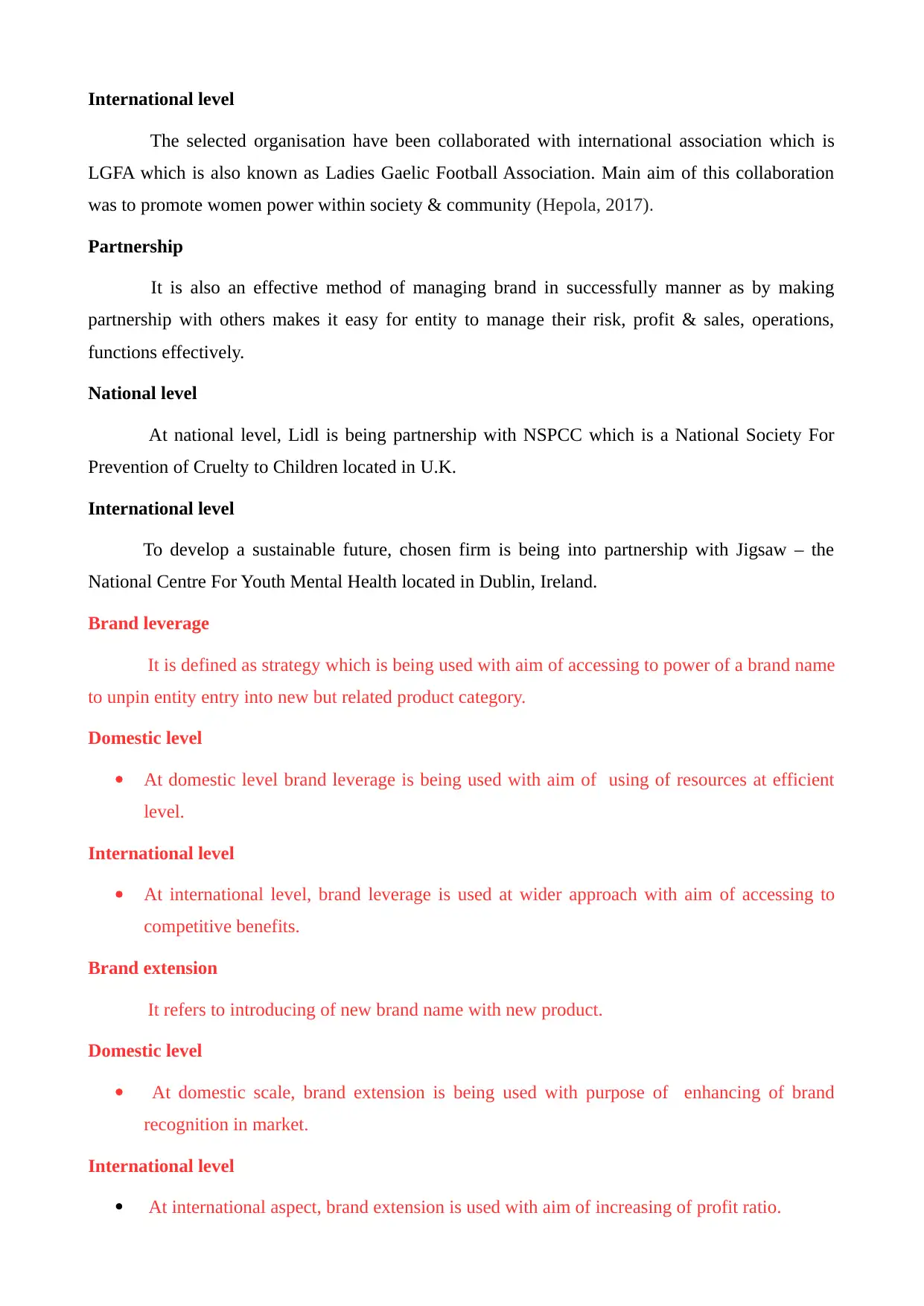
International level
The selected organisation have been collaborated with international association which is
LGFA which is also known as Ladies Gaelic Football Association. Main aim of this collaboration
was to promote women power within society & community (Hepola, 2017).
Partnership
It is also an effective method of managing brand in successfully manner as by making
partnership with others makes it easy for entity to manage their risk, profit & sales, operations,
functions effectively.
National level
At national level, Lidl is being partnership with NSPCC which is a National Society For
Prevention of Cruelty to Children located in U.K.
International level
To develop a sustainable future, chosen firm is being into partnership with Jigsaw – the
National Centre For Youth Mental Health located in Dublin, Ireland.
Brand leverage
It is defined as strategy which is being used with aim of accessing to power of a brand name
to unpin entity entry into new but related product category.
Domestic level
At domestic level brand leverage is being used with aim of using of resources at efficient
level.
International level
At international level, brand leverage is used at wider approach with aim of accessing to
competitive benefits.
Brand extension
It refers to introducing of new brand name with new product.
Domestic level
At domestic scale, brand extension is being used with purpose of enhancing of brand
recognition in market.
International level
At international aspect, brand extension is used with aim of increasing of profit ratio.
The selected organisation have been collaborated with international association which is
LGFA which is also known as Ladies Gaelic Football Association. Main aim of this collaboration
was to promote women power within society & community (Hepola, 2017).
Partnership
It is also an effective method of managing brand in successfully manner as by making
partnership with others makes it easy for entity to manage their risk, profit & sales, operations,
functions effectively.
National level
At national level, Lidl is being partnership with NSPCC which is a National Society For
Prevention of Cruelty to Children located in U.K.
International level
To develop a sustainable future, chosen firm is being into partnership with Jigsaw – the
National Centre For Youth Mental Health located in Dublin, Ireland.
Brand leverage
It is defined as strategy which is being used with aim of accessing to power of a brand name
to unpin entity entry into new but related product category.
Domestic level
At domestic level brand leverage is being used with aim of using of resources at efficient
level.
International level
At international level, brand leverage is used at wider approach with aim of accessing to
competitive benefits.
Brand extension
It refers to introducing of new brand name with new product.
Domestic level
At domestic scale, brand extension is being used with purpose of enhancing of brand
recognition in market.
International level
At international aspect, brand extension is used with aim of increasing of profit ratio.
⊘ This is a preview!⊘
Do you want full access?
Subscribe today to unlock all pages.

Trusted by 1+ million students worldwide
1 out of 18
Related Documents
Your All-in-One AI-Powered Toolkit for Academic Success.
+13062052269
info@desklib.com
Available 24*7 on WhatsApp / Email
![[object Object]](/_next/static/media/star-bottom.7253800d.svg)
Unlock your academic potential
Copyright © 2020–2025 A2Z Services. All Rights Reserved. Developed and managed by ZUCOL.





